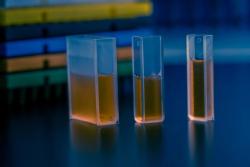
OR WAIT null SECS
- About Us
- Advertise
- Contact Us
- Editorial Info
- Editorial Advisory Board
- Do Not Sell My Personal Information
- Privacy Policy
- Terms and Conditions
© 2025 MJH Life Sciences™ , Pharmaceutical Technology - Pharma News and Development Insights. All rights reserved.
Research initiatives to support science-based pharmaceutical manufacturing
Pharmaceutical Technology Europe
Recent regulatory initiatives have emphasized the need to improve pharmaceutical manufacturing. PAT marked the beginning of a number of regulatory efforts to encourage innovation and a transition towards science-based manufacturing. This article reviews the progress of the regulatory initiatives and describes two significant research initiatives to develop a future pharmaceutical manufacturing environment based on scientific understanding of pharmaceutical materials and processes.
Pharmaceutical companies have followed quality improvement programmes, implemented planning and scheduling tools, and introduced just-in-time and lean manufacturing approaches, but in spite of these efforts the efficiency or level of utilization in pharmaceutical manufacturing is only 15%, according to a study.1 The success of these programmes is often limited because pharmaceutical materials and processes are not thoroughly understood.
Many pharmaceutical processes are based on empirical knowledge, not on fundamental understanding of the physical and chemical interactions. Quality control (QC) laboratories do not generally provide information on the physical aspects that dominate pharmaceutical processes, such as flow properties or particle size distribution of the materials. These important characteristics are frequently ignored, and lack of process understanding limits the efficiency of pharmaceutical manufacturing.
FDA has indicated that product quality is generally adequate for its intended purposes, but the process by which the quality is achieved is inefficient.2 Low manufacturing efficiency leads to high compliance costs with a significant proportion of FDA resources required to ensure adequate product quality. Recurring quality problems are common at many pharmaceutical sites. FDA also maintains a website that lists drug shortages, the majority of which relate to manufacturing problems.3
FDA has started the critical path initiative (CPI), where the critical path is defined as all those activities that occur once a company decides to develop a drug candidate molecule into a product and seek its approval.4–6 The critical path studies indicate that the number of new molecular entities (NMEs) for both small molecules and biotechnology-derived products submitted to FDA has decreased in recent years. The decrease in new products has been accompanied by a significant increase in the cost of bringing a new product to market, and FDA has diagnosed a 'pipeline problem'. The critical path report also discusses the industrialization stage defined as developing the capacity to reliably manufacture a high-quality product at commercial scale. Industrialization is also seen as a frequent hurdle in the critical path-delaying trials, and limiting and delaying access to new products.
Recognizing the difficulties in pharmaceutical manufacturing is an important first step. This article reviews FDA initiatives to improve pharmaceutical manufacturing, and discusses two significant research efforts to develop a future environment based on scientific understanding of pharmaceutical materials and processes.
PAT
FDA started the PAT initiative to increase pharmaceutical process understanding and encourage innovation in pharmaceutical manufacturing.7–10 The efforts to develop this initiative involved several activities to seek industrial feedback. Table 1 lists some of the actions that occurred between the start of discussions on PAT and the guidance issued on September 2004. The table also shows that the PAT initiative served as a first step towards other FDA initiatives.
Table 1 Developments in PAT and GMPs.
PAT has been defined as a "system for designing, analysing and controlling manufacturing through timely measurements (i.e., during processing) of critical quality and performance attributes of raw and in-process materials and processes, with the goal of ensuring final product quality."7 For example, in current pharmaceutical processes fixed blending times are specified. In a PAT system mixing would occur until the system indicates that the blend is homogeneous. A blending period or range would be specified based on the variability that may be expected in the excipients and API. The technology to monitor blending processes is already available and several researchers have shown the feasibility of using near infrared (NIR) spectroscopy to monitor blending processes.11–13 The analytical technology to monitor the process is only one aspect of PAT because its concept also encompasses process design and control.
The PAT guidance describes FDA's regulatory framework to handle PAT proposals from the pharmaceutical industry, and is now part of the broader cGMPs for the 21st Century that FDA has summarized as: "A science and risk-based approach to product quality regulation incorporating an integrated quality systems approach."
PAT contributes to QC by providing a framework for using technology to monitor and control critical quality parameters in processes. Therefore, PAT cannot be implemented without studying and understanding pharmaceutical processes. If a process is not understood, sensors or instruments could be used to monitor all the nonimportant parameters, wasting the effort and investment without any improvements.
Process understanding requires comprehending the fundamental structural properties of excipients and the API, the manner in which these materials interact, and the effect of processing steps on materials. In the majority of formulations, excipients and the API are solids, providing a significant challenge to chemists that have learned chemistry in curricula that focused on liquid and gaseous state reactions. Some of the exciting pharmaceutical process research opportunities are related to the formation of amorphous or crystalline materials,14 or to controlling the crystal form of the API.15 Other efforts are geared to understanding the physics involved in mixing granular materials,16 and the role of nanoparticles to improve material flow.17 Without doubt, research is needed to understand the physical and chemical properties of materials involved in pharmaceutical processes.
The PAT concept emphasizes that product quality should be achieved through the design of effective and efficient manufacturing processes.18 ICH Q8 describes how to include quality by design (QbD) and PAT in a regulatory submission.19 The design space will need to address variations in the chemical and physical properties of excipients and the API, and show that these variations can be managed by the process resulting in a final product that meets the approved specifications. QbD will require additional pharmaceutical process research to understand pharmaceutical materials.
Engineering Research Center
The National Science Foundation (NSF [VA, USA]) recently approved a $15-million (€10.9-million), 5-year grant to implement the Engineering Research Center (ERC) to improve the manufacturing of pharmaceuticals, food and agricultural products. This award was given to more than 30 researchers from Rutgers (NJ, USA), New Jersey Institute of Technology (NJ, USA), Purdue University (IN, USA) and the University of Puerto Rico (Mayagüez, Puerto Rico). The principal objective of this large project is to incorporate materials science and engineering methods in pharmaceutical manufacturing.
Figure 1 shows the engineering approach the ERC is currently following. Once the administration and delivery requirements of an API are known, then engineering is used to obtain an integrated framework with predictive models to systematically design the particles of the API, composites and their manufacturing processes with a reduced number of supporting experiments. The engineering system will be demonstrated in three core technology platforms dedicated to developing specific types of products with predetermined functionalities.
Figure 1
The first development programme, Continuous Manufacturing of Macrocomposites, improves and upgrades two current manufacturing methods: direct compression and roller compaction. The second, Engineered Particle-Based Delivery Systems, focuses on innovative stable suspensions of nano- and microparticles with desired properties. The third, Multilayer Architectures, emphasizes highly innovative product synthesis methods intrinsically suitable for personalized medicine.
Faster, safer, cheaper
The National Institute of Pharmaceutical Technology and Education (NIPTE [www.nipte.org]), was established as a nonprofit multi-university consortium for interdisciplinary research and education in pharmaceutical science and engineering. Its aim is to develop, manufacture and deliver pharmaceutical products faster, safer and at a significantly lower cost to the patient.
The NIPTE's current goal is "to become the pre-eminent interdisciplinary national resource for research and education on science- and engineering-based understanding of pharmaceutical development and manufacturing. Scientists, researchers and engineers from academia, FDA and the industry will collaboratively engage in developing state-of-the-art science and technology to enable the pharmaceutical industry to develop products faster, and at a significantly lower cost with less variability and higher predictability of performance." The executive committee of the NIPTE has estimated that about $25 million (€18 million) is needed annually for the NIPTE to make a significant contribution and meet its goals.
The NIPTE will not be dedicated to the discovery of new pharmacologically active molecules; it will focus on improving pharmaceutical technology, which has been defined as: "Pharmaceutical technology addresses design, development, and manufacturing of all components of drug products, diagnostics, and pharmaceutical devices, including organic molecules, proteins, and other biologics. It also encompasses the physical and engineering sciences of scalable drug delivery platforms."
The NIPTE is developing pharmaceutical manufacturing and education roadmaps, which will pinpoint a number of problems that delay the approval of drug products, increase the cost of their development and lower the efficiency of manufacturing processes. They will also include a vision of the desired state of pharmaceutical development and manufacturing. The path from the current state to the desired state will require overcoming a number of barriers, and advances in various research areas. These research areas are being identified and classified in terms of their importance, with a preliminary estimate of the time and financial resources needed to advance them.
Conclusion
The PAT initiative marked the beginning of a consistent FDA effort to emphasize innovation and science-based pharmaceutical manufacturing. The research initiatives described in this article also support science-based pharmaceutical manufacturing. These regulatory and scientific efforts — and those of many other researchers — are expected to lead to a future science-based pharmaceutical manufacturing environment.
Acknowledgements
The author thanks Dr Prabir Basu at NIPTE and Dr Manel Alcalá at the University of Puerto Rico, Mayaguez for reviewing the manuscript and providing suggestions.
References
1. D. Dean and F. Bruttin, "Productivity and the Economics of Regulatory Compliance in Pharmaceutical Production", PricewaterhouseCoopers, Food and Drug Administration Advisory Committee for Pharmaceutical Science (28 November 2001). www.fda.gov
2. A.S. Hussain, "The Subcommittee on Process Analytical Technologies (PAT): Overview and Objectives", FDA's Advisory Committee for Pharmaceutical Science (25 February 2002). www.fda.gov
3. "Drug Shortages", www.fda.gov
4. "Innovation or Stagnation. Challenge and Opportunity on the Critical Path to New Medical Products", US Food and Drug Administration, 2004. www.fda.gov
5. "Innovation or Stagnation. Critical Path Opportunities Report", US Food and Drug Administration, 2006. www.fda.gov
6. "Innovation or Stagnation. Critical Path Opportunities List", US Food and Drug Administration, 2006. www.fda.gov
7. "PAT — A Framework for Innovative Pharmaceutical Manufacturing and Quality Assurance", in Center for Drug Development and Research (US Food and Drug Administration), 2004.
8. R. Parrilla et al., Journal of Process Analytical Technology, 3(4), 25–28 (2006).
9. R.J. Romañach, Journal of Process Analytical Technology, 3(1), 22–25 (2006).
10. R.J. Romañach, Journal of Process Analytical Technology, 1(1), 10–12 (2004).
11. O. Berntsson et al., Powder Technology, 123(2–3), 185–193 (2002).
12. S. Sekulic et al., Anal. Chem., 68(3), 509–513 (1996).
13. R.D. Maesschalck et al., Appl. Spectrosc., 52(5), 725–732 (1998).
14. N. Rodríguez-Hornedo and D. Murphy, J. Pharm. Sci., 88(7), 651– 660 (1999).
15. C.H. Gu, V. Young and D.J.W. Grant, J. Pharm. Sci., 90(11), 1878–1890 (2001).
16. T. Shinbrot and F.J. Muzzio, "Mixing and Segregation in Tumbling Blenders", in J. Swarbrick, J.C. Boylan, Eds., Encyclopedia of Pharmaceutical Technology2nd Edition (Marcel Dekker, New York, NY, USA, 2002) p 1795.
17. J. Yang et al., Powder Technology, 158(1–3), 21–33 (2005).
18. F. Erni, Journal of Process Analytical Technology, 2(2), 23–26 (2005).
19. ICH Q8, Pharmaceutical Development, US Food and Drug Administration, 2006. www.fda.gov
Key Points
- PAT and QbD will help to prevent recurring QC problems.
- The ERC has been launched to investigate pharmaceutical manufacturing processes.
- The NIPTE has set up a nonprofit multi-university consortium for interdisciplinary research in development and manufacturing.
Rodolfo J. Romañach is professor of chemistry at the University of Puerto Rico (Puerto Rico).



